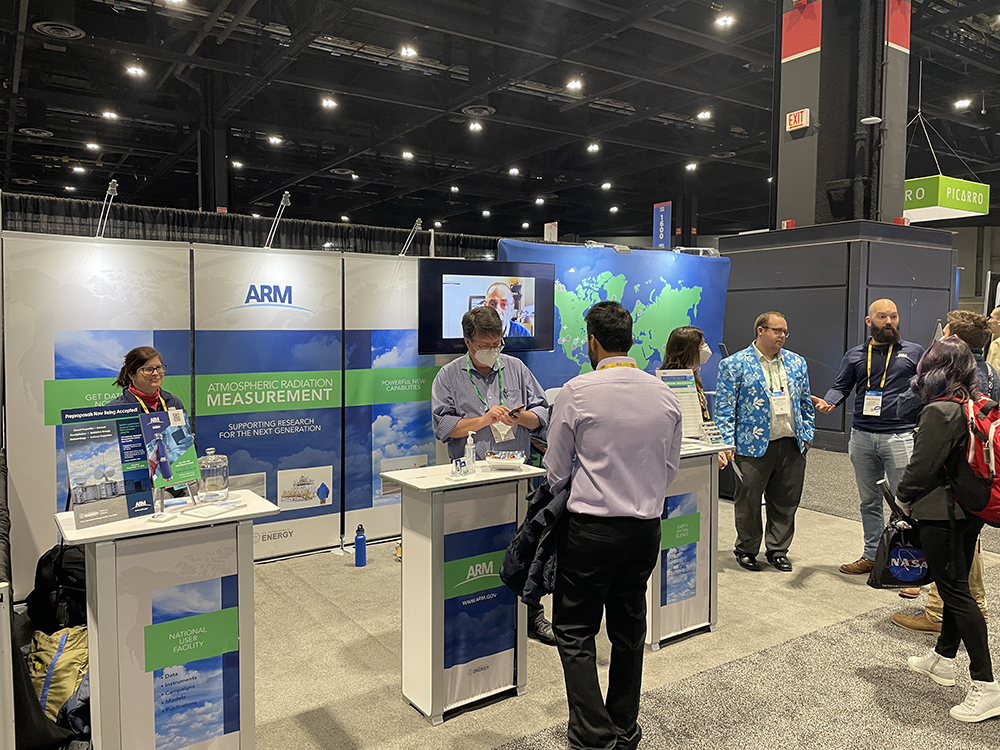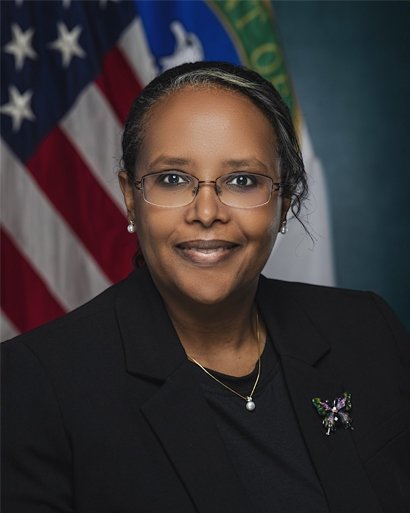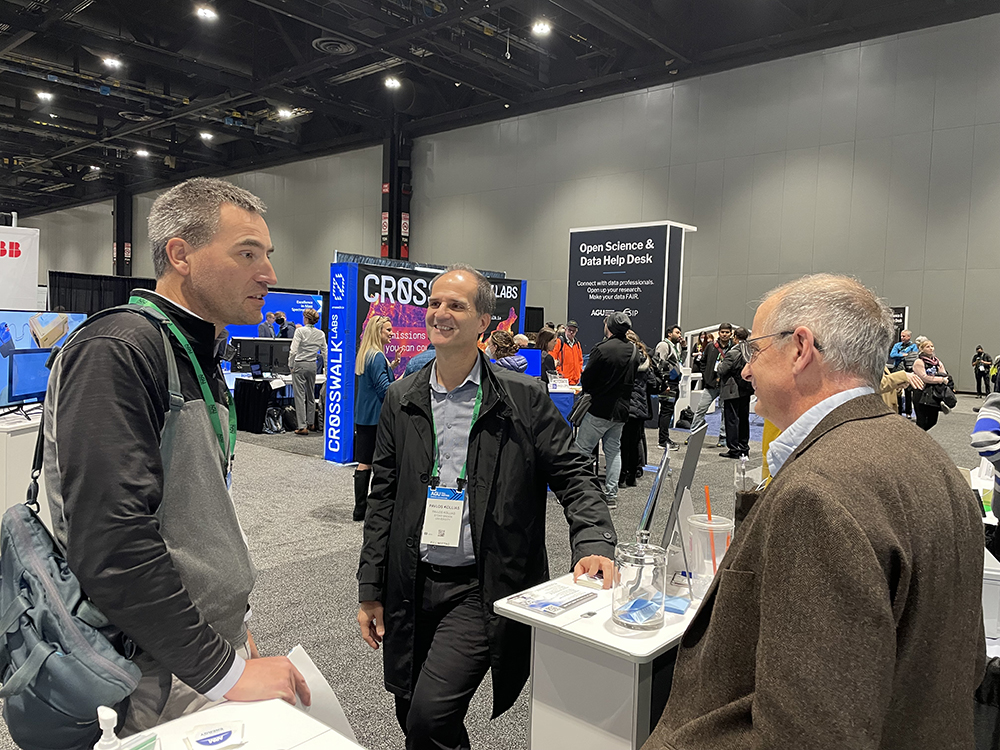More Researchers Get Back to Sharing Science in Person

After COVID altered meeting plans the previous two years, the end of 2022 and the beginning of 2023 brought a welcome return to in-person scientific conferences for many members of the Atmospheric Radiation Measurement (ARM) user facility/Atmospheric System Research (ASR) community.
First up was the 2022 American Geophysical Union (AGU) Fall Meeting from December 12 to 16 in Chicago, Illinois. Right after the new year came the 2023 American Meteorological Society (AMS) Annual Meeting from January 8 to 12 in Denver, Colorado.
Both conferences provided online attendance options for people unable to travel.
On average, AGU draws about 25,000 participants to its fall meeting. Almost 6,600 people attended AMS—its largest attendance in at least a decade.
ARM hosted an in-person exhibit at both conferences, welcoming close to 300 visitors at AGU and more than 500 at AMS. In the exhibit, ARM representatives met with potential users, gave flash talks on ARM capabilities and campaign science, and answered data questions.
ASR leadership participated in the U.S. Department of Energy (DOE) Office of Science’s Biological and Environmental Research (BER) program booth at AGU and had an overview poster at AMS.
Showcasing the scientific impact of ARM’s worldwide data and ASR research, the ARM/ASR community reported 139 presentations at AGU and 86 at AMS.
Despite ending only two months before AGU, the TRacking Aerosol Convection interactions ExpeRiment (TRACER) had plenty of early results to report. The yearlong ARM field campaign gathered data near Houston, Texas, to help scientists understand how dust particles, soot, and other types of aerosols might affect thunderstorms.
Researchers also mined data from ARM’s ongoing Surface Atmosphere Integrated Field Laboratory (SAIL) campaign near Crested Butte, Colorado, for AGU and AMS. Until June 2023, SAIL is collecting data about physical processes and interactions that affect mountain hydrology.
AGU and AMS also held ceremonies to hand out their annual honors. Ten members of the ARM/ASR community received recognition during AGU 2022 and AMS 2023. Read about the honorees.
Inspiration from DOE Leadership

AGU featured a lecture from DOE Office of Science Director Asmeret Asefaw Berhe, who highlighted the work being done among the agency’s 28 user facilities. Data, instruments, and other user facility resources are freely available to researchers who plan to share their work with the scientific community.
Berhe referenced ARM with its six observatories and data collection in some of the world’s most climate-sensitive regions.
“ARM is a key contributor to national and international climate research efforts,” she said.
During AGU, the Office of Science published a blog post from Berhe about ARM’s SAIL campaign and other DOE fieldwork in Colorado to better understand the future of water in the western United States.
In her lecture, Berhe also called attention to new initiatives that aim to build relationships with historically underrepresented institutions and increase the diversity of participants in Office of Science research. DOE ASR Program Manager Shaima Nasiri is a program contact for two of these initiatives: Reaching a New Energy Sciences Workforce (RENEW) and Funding for Accelerated, Inclusive Research (FAIR).
Another new initiative was the focus of an AGU town hall on DOE’s growing engagement in urban climate science.
DOE introduced four recently awarded Urban Integrated Field Laboratories, which will study climate and weather impacts on urban systems in Arizona, Illinois, Maryland, and Texas. These labs will include significant participation from local and Minority Serving Institutions.
TRACER’s lead scientist, Michael Jensen, called the ARM campaign “a precursor, maybe, to some of the urban labs.” Jensen shared early TRACER observations of aerosol properties and sea-breeze dynamics, which he said needed to be quantified to determine aerosol influences on clouds.
DOE ARM Program Manager Sally McFarlane spoke about ARM and ASR’s involvement in urban research, including TRACER and the Green Ocean Amazon (GoAmazon2014/15) campaign in Brazil. Scientists are still using GoAmazon data to study interactions between urban pollution and pristine rainforest air.
Urban regions were at the center of ARM’s latest call for scientists to submit preliminary proposals for ARM Mobile Facility campaigns. The call closed the week after AGU.
Earlier at AGU, McFarlane gave advice to aspiring principal investigators during town halls on research opportunities in BER and successful proposal writing for early career atmospheric scientists.
McFarlane recommended becoming a peer reviewer to learn more about the proposal process and what makes for a quality submission. People interested in joining a review panel for ARM or ASR can contact the program managers.
Past, Present & Future

Among the reported 116 AGU presentations that featured ARM data, a group of sessions explored research from the Multidisciplinary Drifting Observatory for the Study of Arctic Climate (MOSAiC) expedition. Scientists are using MOSAiC data to study coupled atmosphere-ice-ocean processes in the central Arctic.
See all the AGU talks and posters that featured ARM data and ASR science.
With eyes on ARM’s future, ARM Director Jim Mather led an AGU town hall on new capabilities and establishing development priorities within the user facility. ARM Associate Director for Research Jennifer Comstock discussed instruments and data products, and ARM Data Services Manager Giri Prakash presented on ARM data and computing capabilities.
Mather, Comstock, and Prakash surveyed the audience, using real-time polling software to ask the following questions:
- Are there measurements that would complete ARM’s current instrument suite?
- What new data products are you most interested in?
- ARM is investing in several new data analyst positions. What analyses should ARM focus this effort on?
- What types of customized products would benefit your research?
- Are you interested in real-time data access?
- What specific data capabilities will minimize your data preparation time for data analysis?
- Will you be interested in contributing to the open-source software code development with the ARM community?
In addition to considering input from the AGU town hall, ARM has a web form for researchers to suggest new data products, measurements, or services that will help advance their science areas.
The Power of Data and Open Science
In a fitting connection with ARM, AMS 2023 carried the theme “Data: Driving Science. Informing Decisions. Enriching Humanity.”
ARM began AMS with a daylong short course on open science and the SAIL campaign, which is taking place a few hours southwest of Denver.
SAIL’s lead scientist, Daniel Feldman, helped organize the short course with ARM staff members Scott Collis, Max Grover, and Monica Ihli. Attendees learned how to use ARM-supported toolkits to work with SAIL data. SAIL co-investigator Allison C. Aiken showed attendees how to analyze aerosol data from the campaign. Read more about the course.
The timing and topic of the short course dovetailed nicely with an announcement that came during AMS. The White House Office of Science and Technology Policy declared 2023 as the Year of Open Science across the federal government, including DOE.
Out of 74 reported ARM presentations at AMS, 27 covered TRACER and its associated campaigns, including work funded by ASR. As they did at AGU, Jensen and TRACER co-investigator Dié Wang helped convene a session, this one on aerosol-cloud interactions in deep convective clouds.
During the 22nd Annual Student Conference, a session on mesoscale meteorology featured a set of TRACER posters presented by students from the Georgia Institute of Technology and Texas A&M University.
In addition to TRACER, multiple AMS presentations looked at ARM data from SAIL, MOSAiC, and the Cloud, Aerosol, and Complex Terrain Interactions (CACTI) campaign. CACTI focused on the life cycle of convective clouds in Argentina’s Sierras de Córdoba mountain range.
View the full lists of AMS presentations featuring ARM data and ASR science.
Up Next
AGU 2023 will be from December 11 to 15 in San Francisco, California. The 104th AMS Annual Meeting will be held from January 28 to February 1, 2024, in Baltimore, Maryland. Both meetings will again be hybrid.
# # #This work was supported by the U.S. Department of Energy’s Office of Science, through the Biological and Environmental Research program as part of the Atmospheric System Research program.

